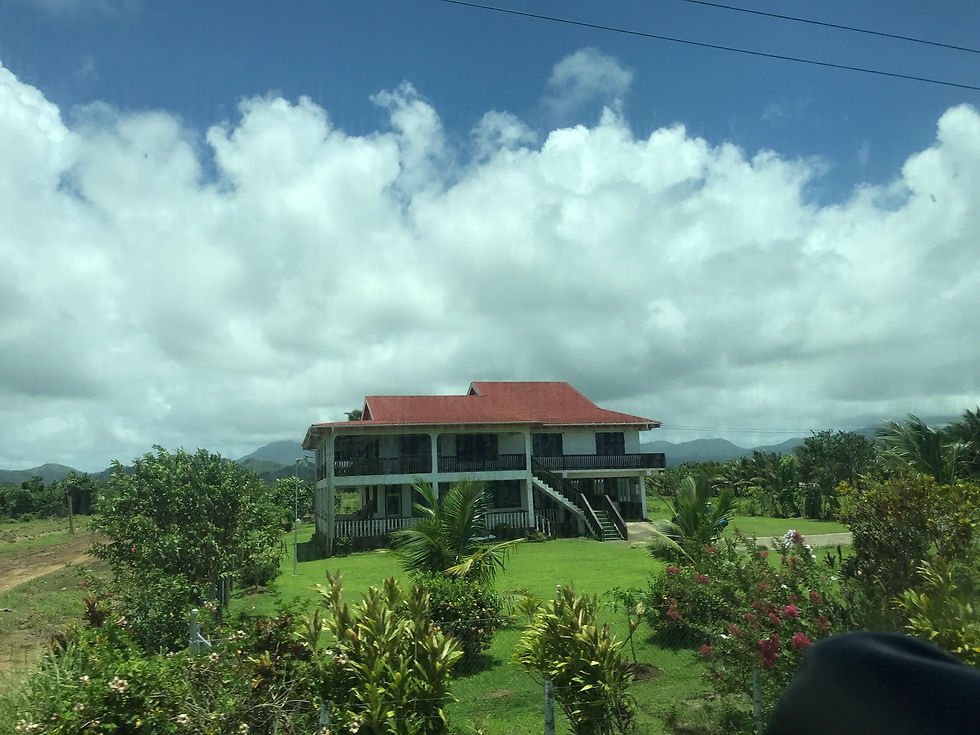Cannibals!
- Susan Nash

- Jan 26, 2018
- 3 min read

Note: It is really January 26, but the blog site doesn’t believe me. Until the mid 1800’s, Fijians cooked and ate their enemies in order to show their power over them and to instill in themselves the enemies’ strength. I believe the preferred method was baking with hot rocks in a pit. Think roast suckling pig.
The victim did not have to be a rival. Rudeness was also punishable by grisly death. An early missionary, Thomas Baker in 1867, made the mistake of touching a chief’s head. NO! NO! NO! All that remains of him — you can see it in a museum — is the sole of one boot.
We were instructed not to wear anything that exposed our knees and not to wear a hat. Both are insults in Fijian culture. We had only half a day in and near Suva, the largest city in the South Pacific and the capital of this Melanesian nation comprised of around 332 islands, of which about 110 are inhabited. Volcanic activity can give or take the number of islands, so there’s no exact count. Total population is about 900,000. Many Indians came as indentured workers to work on the plantations, and today about half the population are Indian descendants. There are many Hindus and Muslims: Hindu households fly a red flag, and Muslim houses are painted green. Here are a few shots of downtown Suva, which is located on the island of Vitu Levu. The first two are the view from my balcony. The funny shaped gray building on the left is a six-story department store.

From my balcony in the other direction. Suva is a huge port, with acres and acres of containers.

Below: It wasn’t raining. That’s dirt.

I should hope it would be ‘food for less.’

The country has been independent from Britain since 1970, but all has not been plain sailing. In 1987 there were two coups d’état, then a civilian coup in 2000 and a military coup in 2006. The economy is based on coconut, gold, timber. But, of course, tourism is No. 1.
I decided in such a short visit to get a taste (sorry) of Fijian history and spent several hours at an Arts Center (the usual ticky tacky shoppes) that puts on what they call the Firewalking Spectacular. Our bus guide on the total hour-and-a-half road trip was one of the best so far, as was our host at the Arts Center, conveying all sorts of historic, cultural and lifestyle facts and feelings about Fiji. I don’t know if it’s an official average, but our guide mentioned a monthly salary of $300. Cyclone Winston ravaged the island in 2016. Wiki says it was ‘the most intense tropical cyclone in the Southern Hemisphere on record, as well as the strongest to make landfall in the Southern Hemisphere.’ Many homes had to be rebuilt, and the Health Department required that all new construction have indoor plumbing. Road shots on the way to and from the Firewalking...

I assume this is a scrapyard.




And, finally, The Main Event!
The beautiful venue for the spectacular.

The welcoming committee. The most badass musician had the tiniest instrument — a ukulele of course!

For the Firewalk: The rocks are heated up with long planks that burn until they’re pulled out of the heap. After the rocks have been fired up, the elf spirits — represented by the plants hanging from the pole — are held over the hot spot. This ceremony is all about driving out evil spirits.

Then the walkers make their way very carefully across the hot rocks. Our excellent guide whispered to me me that it really hurts, but, after five or six times, you get used to it. Quote unquote.

Act II was the ladies, wearing colorful headdresses made of assorted hibisus that bauble and bobble as they dance and sing.

Act III was a fearsome battle between two tribes which began with a war dance designed to get the testosterone pumping and ended with a near-miss wardrobe malfunction.



In a mano a mano battle to the death, the victor stood on the chest of the dead victim...

...whose body was then carried back to the winners’ village. Can you guess what happened to the body? But it didn’t end with him: all the women in the losing village and all the children were also rounded up. The women were killed, and the children were tied to trees and used for target practice. And eaten. It is hard to believe that cannibalism existed here until the mid-1800’s.

We are about to leave the ‘native’ islands where we learned about the original inhabitants from their descendants. Next stop: New Zealand, where we will learn about the native Maori culture. And The Lord of the Rings. #








Comments